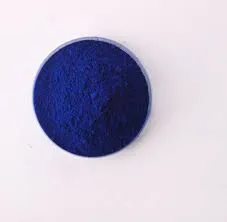Leading Suppliers of Sulphur Dyes for Textile and Industrial Applications Worldwide
The Global Industry of Sulphur Dye Manufacturers
In the realm of textile manufacturing, dyes play an essential role in transforming raw fabrics into colorful, appealing products. Among the various types of dyes available, sulphur dyes have established a significant presence due to their unique properties and applications. Sulphur dyes are primarily used for dyeing cotton and other cellulosic materials and are known for their vibrant colors and outstanding fastness properties. This article delves into the processes and challenges faced by sulphur dye manufacturers, market trends, and the future of this vital industry.
Understanding Sulphur Dyes
Sulphur dyes are derived from a chemical compound containing sulphur and are recognized for their excellent wash, light, and rub fastness. They are predominantly used in the dyeing of natural fibers, especially cotton. One of the key advantages of these dyes is their ability to produce deep shades with relatively good color fastness. The dyeing process involves the reduction of sulphur compounds to produce soluble sulphide forms, which can then penetrate the fiber. Once the dyeing process is complete, the dyes and fibres are oxidized, leading to the reformation of the insoluble dye within the fiber, resulting in a stable and lasting coloration.
The Manufacturing Process
The manufacturing of sulphur dyes involves several stages that require precision and a robust understanding of chemical interactions. Firstly, raw materials, including a variety of aromatic compounds, are sourced and processed. These materials undergo sulfonation to introduce sulfonic acid groups, making the dye water-soluble. The resulting dye compounds are then subjected to various chemical reactions to develop colors and shades that are desirable for the textile market.
Quality control is crucial in the production of sulphur dyes, as inconsistencies can lead to variations in shade or fastness properties. Manufacturers often use advanced technologies and practices to ensure the final product meets strict industry standards. Analytical methods such as UV-Vis spectrophotometry and HPLC (High-Performance Liquid Chromatography) are commonly employed for quality assessment.
Market Trends and Challenges
sulphur dye manufacturers

The global market for sulphur dyes has been steadily evolving, driven by growing demand from the textile industry, particularly in Asia, which is the largest consumer of these products. Countries like India and China are leading producers and exporters, benefiting from low labor costs and established supply chains. However, manufacturers face several challenges, including environmental regulations concerning the emission of harmful chemicals during the dyeing process. Stringent regulations are prompting companies to adopt greener practices and invest in technologies that minimize ecological impact.
Another growing concern is the increasing demand for sustainable and eco-friendly products. Consumers are becoming more environmentally conscious, leading to a shift towards dyes that are less harmful to the planet. As a response, many sulphur dye manufacturers are researching and developing new dyes that are based on renewable resources and produce less waste.
Innovations in Sulphur Dye Manufacturing
To address these challenges, manufacturers are exploring innovative solutions. Research into bio-based dyes and the use of enzymes in the dyeing process are promising areas of development. These innovations could potentially reduce the environmental footprint of dyeing operations while maintaining the quality and performance of traditional sulphur dyes.
Moreover, digital dyeing technologies and advancements in textile printing methods are gaining traction. These methods allow for more precise color application and reduce waste by using only the necessary amount of dye, which is a significant advancement in the search for sustainable practices in the dyeing industry.
The Future of Sulphur Dye Manufacturers
The outlook for sulphur dye manufacturers is shaped by the balancing act of meeting consumer demands while adhering to environmental standards. As companies strive for sustainability, the integration of digital technologies, automation, and innovative materials will likely play a significant role in advancing manufacturing processes.
In conclusion, sulphur dye manufacturers are at a pivotal point where innovation and sustainability converge. By embracing new technologies and environmentally friendly practices, the industry can ensure its growth while minimizing its impact on the environment. As the global textile market continues to evolve, the role of sulphur dyes will remain vital, but the challenge lies in adapting to the changing demands of consumers and regulations. This journey towards sustainable practices will be crucial in defining the future of sulphur dye manufacturing and its place in the textile industry.
-
The Timeless Art of Denim Indigo Dye
NewsJul.01,2025
-
The Rise of Sulfur Dyed Denim
NewsJul.01,2025
-
The Rich Revival of the Best Indigo Dye
NewsJul.01,2025
-
The Enduring Strength of Sulphur Black
NewsJul.01,2025
-
The Ancient Art of Chinese Indigo Dye
NewsJul.01,2025
-
Industry Power of Indigo
NewsJul.01,2025
-
Black Sulfur is Leading the Next Wave
NewsJul.01,2025

Sulphur Black
1.Name: sulphur black; Sulfur Black; Sulphur Black 1;
2.Structure formula:
3.Molecule formula: C6H4N2O5
4.CAS No.: 1326-82-5
5.HS code: 32041911
6.Product specification:Appearance:black phosphorus flakes; black liquid

Bromo Indigo; Vat Bromo-Indigo; C.I.Vat Blue 5
1.Name: Bromo indigo; Vat bromo-indigo; C.I.Vat blue 5;
2.Structure formula:
3.Molecule formula: C16H6Br4N2O2
4.CAS No.: 2475-31-2
5.HS code: 3204151000 6.Major usage and instruction: Be mainly used to dye cotton fabrics.

Indigo Blue Vat Blue
1.Name: indigo blue,vat blue 1,
2.Structure formula:
3.Molecule formula: C16H10N2O2
4.. CAS No.: 482-89-3
5.Molecule weight: 262.62
6.HS code: 3204151000
7.Major usage and instruction: Be mainly used to dye cotton fabrics.

